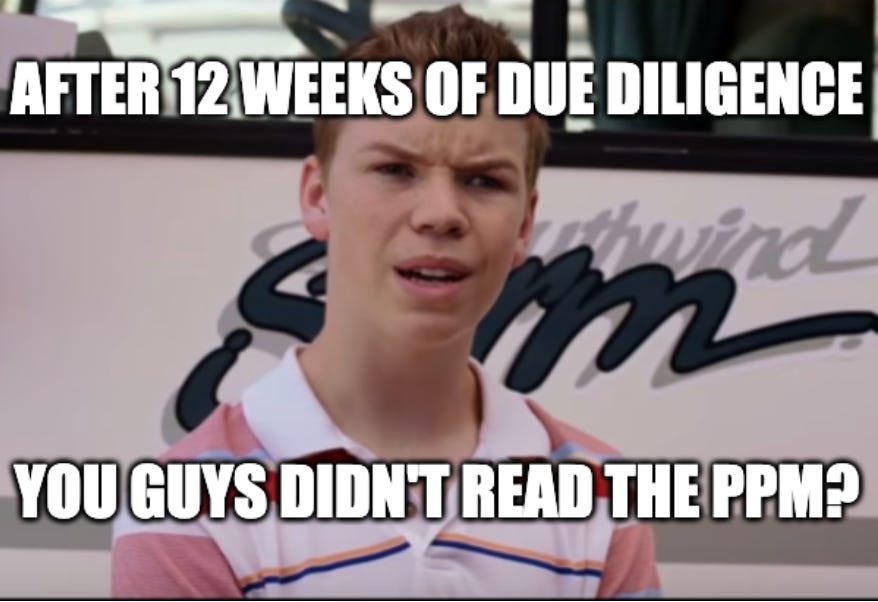How to Read a PPM and LPA Without Losing Your Mind (Hint: AI Can Help)
Key sections, red flags, and AI prompts every LP should know
If you’re like most investors, you’d rather stab your eyes with a fork than plow through 200+ pages of legal documents - the Private Placement Memorandum (PPM) and the Limited Partnership Agreement (LPA). And after spending tens (hundreds?) of hours on due diligence, it’s tempting to assume the GP’s lawyer is looking out for you.
Hate to break it: they’re not. The lawyer drafting the PPM works for the GP, not for you.
That leaves most LPs in a tough spot. Unless you’re an endowment with an in-house legal team, the responsibility to review these documents falls squarely on your shoulders. We’ve shared insights from securities attorneys before. Today, we’re taking a different angle: a practitioner’s guide to reviewing subscription documents.
👉 And stick around until the end: I’ll share the AI prompts I use to review PPMs and LPAs. They’ll help you shortcut the process and walk away with a list of questions for your attorney (if you choose to engage one).
✨Read more on using AI to simplify your due diligence process here.
⚠️ Important: This content is for educational purposes only. It is not legal or investment advice, and should not be relied on as such. Always consult a qualified attorney before making any investment decisions.
Investor Community Spotlight: Boulder Investment Group (BIG)
The number one question I hear from fellow LPs is, “How do I see more quality deals?” A close second: “Where do I meet other LPs?”
BIG answers both. It’s a volunteer-run investment club of 950+ sophisticated investors (87% are qualified purchasers). Since 2009, members have invested more than $1.4B in offerings presented through the group.
Community: meet and network with other investors.
Curated access: only opportunities with a proven track record and verified member referrals make the cut.
Deal flow + education: pitch meetings every six weeks feature both investments and expert perspectives.
Learn more and apply for membership here:
(Full disclosure: this post is NOT sponsored. I’ve been a member since 2022 and currently serve on the board of directors.)
The PPM: Your Window into the Risks and the Pitch
Think of the PPM as the GP's sales brochure and legal disclosure document rolled into one. It outlines the fund's strategy, the risks involved, and how the GP plans to use your money (ideally, to make you more money).
Risk Factors
Skim: generic “market risk,” “recession risk,” etc.
Focus: risks tied to the actual strategy. Example: an industrial real estate fund should address environmental liabilities and potential tenant disputes, etc. A PE fund should highlight risks specific to the target industry. You get the idea.
📌 If the PPM identifies a risk that feels like it’s not fully addressed by the fund’s strategy, that’s a conversation you need to have with the GP.
Use of Proceeds / Fees
How much of your capital funds investments vs. fees/expenses?
📌 Fees: compare the fees described in the PPM to the more detailed allocation rules in the LPA. It’s not uncommon to see a lack of clarity on what expenses are covered by the management fee versus what gets passed on to the fund.
More on fees in real estate private equity:
GP Disclosures & Conflicts
The PPM will include a section on the GP's background, including litigation history, regulatory actions, and conflicts of interest.
📌 Related-Party Transactions: this is a key area for potential conflicts. Does the GP have other funds or businesses that could be doing business with this new fund? Look for details on how these conflicts will be managed. For example, if a real estate fund plans to use a property management company owned by the GP, the PPM should clearly state how fees will be set to ensure they are at "arm's length" (i.e., fair market value).
The LPA: The Rules of the Game
While the PPM outlines the what and why, the LPA dictates the how. It is the legally binding document that governs the entire partnership, from capital calls to carried interest.
Management Fees & Expenses
Look for vague language allowing the GP to pass through a wide range of expenses to the fund. Common pass-throughs include legal fees, travel, deal-sourcing costs, and even "broken-deal" costs for failed transactions.
📌 A strong LPA will have specific caps or clear definitions on what can be charged to the fund, preventing the GP from nickel-and-diming LPs.
Fee Offsets
This is an investor-friendly clause. If the GP or its affiliates receive transaction or monitoring fees from portfolio companies, the LPA should specify that these fees offset the management fee.
📌 This prevents the GP from double-dipping and ensures alignment with LPs.
Distribution Waterfall & Clawbacks
The distribution waterfall outlines how cash flows back to investors and the GP. While the waterfall dictates the order of payments, the clawback is the safety net for LPs.
European vs. American:
European-style: GP must return all committed capital and achieve the preferred return before receiving any carried interest.
American-style: GP can take carried interest deal-by-deal, which increases the risk of clawbacks if the fund as a whole underperforms.
More on waterfalls:
📌 Make sure the clawback provision is robust and clearly outlines how a GP will repay any excess distributions.
Key-Man & GP Removal Rights
The Key-Man Clause defines what happens if a key individual (the "key man") in the fund’s leadership team leaves.
📌 A strong clause triggers automatic suspension of the investment period, giving LPs the power to approve a replacement or dissolve the fund. A weak clause may only suspend the fund briefly or have vague definitions.
GP Removal Clause: while rare, it allows a supermajority of LPs (75–80%) to vote out the GP, typically for “cause” (fraud, gross negligence) or sometimes “no-fault.”
📌 The mere presence of this clause can serve as a powerful deterrent against bad behavior. In practice, though, in a deal or fund with hundreds of individual investors, rallying enough LPs to take action can be extremely difficult.
Transfer & Liquidity Mechanics
Private investments are illiquid by nature, but the LPA defines your limited exit options.
Permitted Transfers: the LPA will detail under what circumstances an LP can transfer its interest. This is typically limited to family members or affiliates and requires the GP's consent.
📌 Don’t expect to sell your stake without significant friction.
🤖 LLM PPM & LPA Review Template
Before you dive into documents, here’s a framework you can use with a large language model (LLM) to speed up your PPM and LPA review. Think of it as your AI-powered first pass: it won’t replace your attorney, but it can highlight key sections, summarize clauses, and flag potential risks so you know where to dig deeper.
You can use any LLM you’re comfortable with (ChatGPT, Claude, Perplexity, etc.). Personally, I like NotebookLM because it restricts outputs to your uploaded documents and supports large attachments. Another option is Manus (just note the free plan is pretty limited).
Instructions for LLM:
You are an expert limited partner conducting due diligence on private fund documents. Your goal is to identify key clauses, summarize them in plain language, flag potential risks, and suggest actionable LP steps.
Follow these steps in order, producing output in tables wherever possible.
Step 1: Identify Key Sections
Prompt:
Identify all LP-relevant sections in the following excerpt. Focus on:
PPM: Risk Factors
LPA: Management & Advisory Fees, GP Removal, Key-Man Provisions, Distribution Waterfall, Clawback
For each section, provide:
Section Name
Purpose for LPs (1–2 sentences)
Any particularly noteworthy points
Step 2: Summarize Clauses
Prompt:
For each identified section, summarize the content in plain language. Focus on what the clause actually means for LPs. Avoid legal jargon.
Step 3: Identify Red Flags
Prompt:
Review each summarized clause and identify any potential red flags for LPs. Consider:
Ambiguous language giving GP discretion
Flag discrepancies between the PPM and LPA
Fee structures and lack of offsets
Weak key-man or GP removal clauses
Deal-by-deal waterfalls without strong clawbacks
Provisions limiting GP fiduciary duty
Step 4: Suggest LP Actions
Prompt:
For each red flag identified, suggest practical LP actions, such as questions to ask the GP, provisions to renegotiate, or monitoring steps during fund life.
Step 5: Executive Summary
Prompt:
Produce an LP-ready executive summary. Include:
Key sections and their importance
Major red flags
Suggested LP actions
Any unusual or noteworthy clauses
Bottom Line
PPMs and LPAs may be long and boring, but they define your rights as an investor. Don’t give up in the final stretch of your due diligence process: read carefully, ask questions, and use every tool (including AI) to make your diligence smarter and more efficient. And please… don’t ever let me hear you signed these docs without reading.







